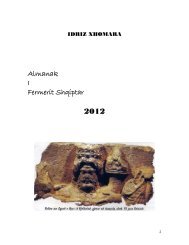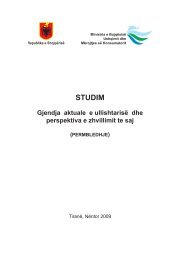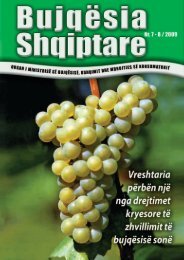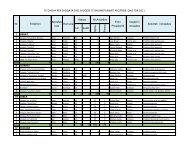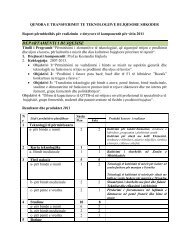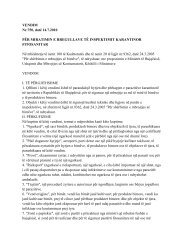MEAT Sector Analyse
MEAT Sector Analyse
MEAT Sector Analyse
- TAGS
- sector
- analyse
- mbumk.gov.al
Create successful ePaper yourself
Turn your PDF publications into a flip-book with our unique Google optimized e-Paper software.
PIGS S – Strengths W – Weaknesses<br />
Internal factors Internal factors<br />
Animals<br />
Breeds, flock<br />
size …<br />
Meat <strong>Sector</strong> Study<br />
Large white, landrace are good Cross-breeds and other breeds less<br />
profitable<br />
17 farms with more than 50 pigs; 40,000 farms with 1 - 5 pigs mostly<br />
DZIRA - 30 sows and 6 - 800<br />
fattening pigs per year<br />
for auto-consumption<br />
Stables Good stables at commercial farms Poor, dark premises at subsistence<br />
farms<br />
Manure First farms under construction with No manure removal systems in<br />
handling advanced technology, also in place; manure is used as fertilizer<br />
manure management<br />
on the fields and slurry just runs into<br />
the nearby river; does not respect<br />
environmental standards<br />
Feeding High input of concentrates, On small farms low input (low<br />
sometimes farms have on feed concentrates), home grown fodder<br />
mixing; expensive production - from limited fields; feed<br />
sometimes maize grown<br />
concentrates expensive as imported<br />
Technology, Bigger farms have tractors and On the farm small farmers do<br />
mechanisation agr.equipment<br />
everything by hand - feeding,<br />
…<br />
removing the manure, etc... On the<br />
fields machinery is missing,<br />
sometimes they buy (expensive)<br />
services from private tractor owners<br />
Slaughtering On farm slaughtering in basic For auto-consumption slaughtering<br />
(location, live slaughter rooms; on bigger farms takes place on farm without<br />
weight …)<br />
Farmer<br />
veterinary inspection takes place veterinary control (also relevant for<br />
local sales); much slaughtering in so<br />
called slaughtering points - often<br />
along major roads<br />
Slaughter-weights 70 - 120 kg alive;<br />
no uniform products - at least not<br />
from small holders; lack of<br />
knowledge about low-fat meat<br />
production which is best preferred -<br />
20-30 % of carcass weight loss<br />
because of fat, affects heavily profit<br />
reduction<br />
Education Educational background is limited<br />
as almost no vocational schools<br />
which would be needed to train<br />
small holders.<br />
Focus / Highly focused if commercially done Subsistence farmers have<br />
specialisation<br />
additionally few chickens for autoconsumption<br />
Meat <strong>Sector</strong> Study, page 54



